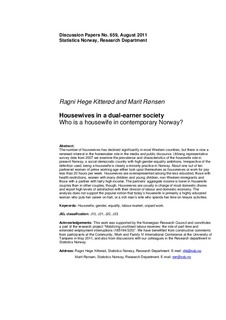Housewives in a dual-earner society. Who is a housewife in contemporary Norway?
Working paper
Permanent lenke
http://hdl.handle.net/11250/180303Utgivelsesdato
2011Metadata
Vis full innførselSamlinger
- Discussion Papers [1003]
Sammendrag
The number of housewives has declined significantly in most Western countries, but there is now a
renewed interest in the homemaker role in the media and public discourse. Utilising representative
survey data from 2007 we examine the prevalence and characteristics of the housewife role in
present Norway, a social-democratic country with high gender-equality ambitions. Irrespective of the
definition used, being a housewife is clearly a minority practice in Norway. About one out of ten
partnered women of prime working age either look upon themselves as housewives or work for pay
less than 20 hours per week. Housewives are overrepresented among the less educated, those with
health restrictions, women with many children and young children, non-Western immigrants and
those with a partner with fairly high income. The partners’ aggregate income is lower in housewife
couples than in other couples, though. Housewives are usually in charge of most domestic chores
and report high levels of satisfaction with their division of labour and domestic economy. The
analysis does not support the popular notion that today’s housewife is primarily a highly educated
woman who puts her career on halt, or a rich man’s wife who spends her time on leisure activities.
